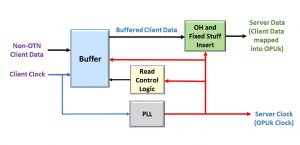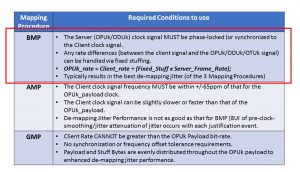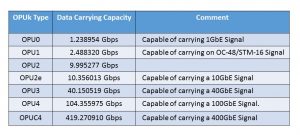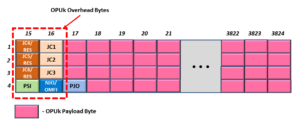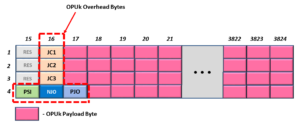What is the PSI – Payload Structure Identifier (Byte and Message)?
The PSI Byte
The PSI (or Payload Structure Identifier) byte is an Overhead byte within the OPUk structure.
Figure 1 presents an OPU frame with the location of the PSI byte identified.

Figure 1, Illustration of an OPUk Frame Structure with the Overhead Bytes (along with the PSI Byte) Identified
The purpose of the PSI byte is to permit an OTN Path Terminating Equipment (PTE) to transport a 256-byte PSI (payload structure identifier) message throughout the OTN (Optical Transport Network).
The primary purpose of this 256-byte PSI Message is to permit the Source PTE to alert the OTN (Network) of the type of data (or traffic) we are transporting within this particular OPU data stream.
Since each OPUk frame contains only 1 PSI byte, an OTN PTE will have to transmit 256 consecutive OPU frames to transmit this PSI message completely.
The OTN PTE will align its transmission of this 256-byte PSI message with the MFAS byte.
Please see the OTUk Frame Structure post for more information on the MFAS byte.
In other words, whenever the OTN PTE is transmitting an OTUk frame with the MFAS byte set to “0x00”, then the OTN PTE will also be sending the first byte of the PSI message (e.g., PSI[0]) via the PSI byte-field.
Likewise, whenever the OTN PTE is transmitting an OTUk frame with the MFAS byte set to “0x01”, then the OTN PTE will also be sending the second byte within this 256-byte message (e.g., PSI[1]) via the PSI byte field, and so on.
Two Types of PSI Messages
An OTN Source PTE will transport one of two types of PSI Messages.
- The Non-Multiplexed Traffic – PSI Message, and
- The Multiplexed Traffic – PSI Message.
I will describe each of these types of PSI Messages below.
The Non-Multiplexed Traffic PSI Message
We will use the Non-Multiplexed Traffic PSI Message when transporting Non-Multiplexed Traffic within our OPU data stream.
Examples of Non-Multiplexed Traffic would be:
- Transporting 1000BASE-X via an OPU0 signal
- 10GBASE-R via an OPU2e signal.
- 100GBASE-R via an OPU4 Signal.
In other words, we are handling Non-Multiplexed Traffic whenever we only transport a single Non-OTN client signal via this OPUk data stream.
I present an illustration of an OPU Frame, with the PSI field highlighted (along with a break-out of the Non-Multiplexed Traffic type of PSI Message) below in Figure 2.

Figure 2, Illustration of an OPU Frame, transporting the Non-Multiplexed traffic of PSI Message
NOTE: The easiest way to tell if you’re working with the Non-Multiplexed Traffic type of PSI Message is to check and see if you see the CSF (Client Signal Fail) bit-field in PSI Byte # 2.
If the CSF bit-field is present, you’re dealing with the Non-Multiplexed Traffic type of PSI Message.
If the CSF bit-field is NOT present (within the PSI Message), then you are dealing with the other type of PSI Message.
The Multiplexed Traffic Type of PSI Message
We use the Multiplexed Traffic type of PSI Message anytime we work with an OPU server signal transporting numerous lower-speed ODUj Tributary Signals.
For example, if we mapped and multiplexed 80 ODU0 tributary signals into an OPU4 server signal, then this OPU4 signal would transport the Multiplexed Traffic type of PSI Message.
Figure 3 presents an illustration of an OPU Frame, with the PSI field highlighted, along with a break-out of the Multiplexed Type of PSI Message.

Figure 3, Illustration of an OPU Frame transporting the Multiplexed Traffic Type of PSI Message
Again, one big difference between the Multiplexed Traffic type of PSI Message and that for Non-Multiplexed Traffic is that the Multiplexed Traffic type of PSI Message will not have the CSF (Client Signal Fail) bit-field.
New Comprehensive OTN Training…Available Now. Click on the Banner Below to Learn More!!
Discounts Available for a Short Time!!!
The PSI Message
The PSI (Payload Structure Identifier) message is a 256-byte message that an OTN terminal will transport via the PSI byte for 256 consecutive OPUk/ODUk/OTUk frames.
Let’s talk a little bit about the data that we are transporting within these PSI Messages.
PSI[0] – or PSI Byte # 0 – PT (Payload Type)
The first byte of the PSI Message (e.g., PSI[0]) carries the Payload Type (or PT) value. The PT byte identifies the type of client data the OPUk structure is transporting via its payload.
First, Table 1 presents a list of standard PT values and the corresponding client data types (being transported within the OPUk Structure).
Table 1a, PT (PSI[0]) Values, and the Corresponding Client Data within the OPUk Structure – Part I

Table 1b, PT (PSI[0]) Values, and the Corresponding Client Data within the OPUk Structure – Part II

NOTES:
- We will discuss the PT = 0x07 case when mapping 100GBASE-R into an OPU4 in Lesson 4.
- Access to Lesson 4 requires that you have a membership to “THE BEST DARN OTN TRAINING PERIOD” training.
Table 1c, PT (PSI[0]) Values, and the Corresponding Client Data within the OPUk Structure – Part III

NOTE:
- We will discuss cases where PT = 0x20 and 0x21 in Lesson 5.
- Access to Lesson 5 requires that you have a membership to “THE BEST DARN OTN TRAINING PERIOD” training.
Table 1d, PT (PSI[0]) Values, and the Corresponding Client Data within the OPUk Structure – Part IV

Other posts contain detailed information on how ITU-T G.709 recommends that the System Designer map each client signal into their corresponding OPUk structure.
Click HERE for more information about the PT = 0x21 Method for Mapping/Multiplexing Lower-Speed ODUj signals into a Higher-Speed ODUk Signal.
The Remaining Bytes within the PSI Message
PSI bytes 1 and 3 through 255 are for “Mapping and Concatenation Specific” roles that we will discuss in another post.
In Multiplexed-Traffic Type of PSI Messages
For the Multiplexed-Traffic type of PSI Message, we use these bytes to transport MSI (Multiplex Structure Identifier) information throughout the OTN.
In other words, we will transport the MSI information (via these PSI Messages) for applications in which we are mapping/multiplexing lower-speed ODUj tributary signals into higher-speed OPUk/ODUk server signals.
The MSI aims to identify these lower-speed ODUj tributary signals we are transporting via this OPUk/ODUk signal to the OTN.
You can think of the MSI as a passenger list or manifest of lower-speed ODUj tributary signals riding along (or being transported) within this OPUk server signal.
In Non-Multiplexed-Traffic Type of PSI Messages
PSI byte 2, Bit 1 (for the Non-Multiplexed Traffic PSI Message) is the CSF (or Client Signal Fail) indicator. The ITU-T Standards Committee has reserved PSI Byte 2, Bits 2 through 8 for “future standardization.”
We discuss the CSF indicator and the MSI information in other posts.
We also extensively discuss these PSI Messages within THE BEST DARN OTN TRAINING PRESENTATION….PERIOD!!!.
You can click on the Banner below to learn more our this training package.
Has Inflation got You Down? Our Price Discounts Can Help You Beat Inflation and Help You Become an Expert on OTN!! Click on the Banner Below to Learn More.
Discounts Available for a Short Time ONLY!!
For More Information on OTN-Related Posts in this Blog, click on the image below.






